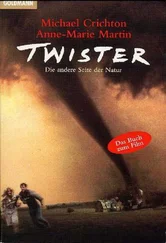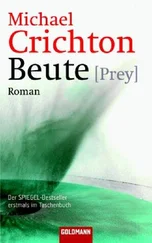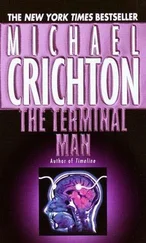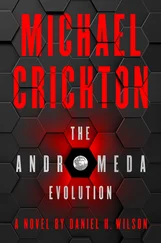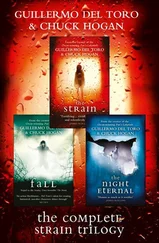Michael Crichton - The Andromeda Strain
Здесь есть возможность читать онлайн «Michael Crichton - The Andromeda Strain» весь текст электронной книги совершенно бесплатно (целиком полную версию без сокращений). В некоторых случаях можно слушать аудио, скачать через торрент в формате fb2 и присутствует краткое содержание. Жанр: Детская проза, на английском языке. Описание произведения, (предисловие) а так же отзывы посетителей доступны на портале библиотеки ЛибКат.
- Название:The Andromeda Strain
- Автор:
- Жанр:
- Год:неизвестен
- ISBN:нет данных
- Рейтинг книги:5 / 5. Голосов: 1
-
Избранное:Добавить в избранное
- Отзывы:
-
Ваша оценка:
- 100
- 1
- 2
- 3
- 4
- 5
The Andromeda Strain: краткое содержание, описание и аннотация
Предлагаем к чтению аннотацию, описание, краткое содержание или предисловие (зависит от того, что написал сам автор книги «The Andromeda Strain»). Если вы не нашли необходимую информацию о книге — напишите в комментариях, мы постараемся отыскать её.
The Andromeda Strain — читать онлайн бесплатно полную книгу (весь текст) целиком
Ниже представлен текст книги, разбитый по страницам. Система сохранения места последней прочитанной страницы, позволяет с удобством читать онлайн бесплатно книгу «The Andromeda Strain», без необходимости каждый раз заново искать на чём Вы остановились. Поставьте закладку, и сможете в любой момент перейти на страницу, на которой закончили чтение.
Интервал:
Закладка:
All these projects were highly theoretical, and all were staffed by prestigious scientists. Admission to the ARPL was a mark of considerable status, and it ensured future funds for implementation and development.
Therefore, when Stone's committee submitted an early draft of the Life Analysis Protocol, which detailed the way any living thing could be studied, the Defense Department responded with an outright appropriation of $22,000,000 for the construction of a special isolated laboratory. (This rather large sum was felt to be justified since the project had application to other studies already under way. In 1965, the whole field of sterility and contamination was one of major importance. For example, NASA was building a Lunar Receiving Laboratory, a high-security facility for Apollo astronauts returning from the moon and possibly carrying bacteria or viruses harmful to man. Every astronaut returning from the moon would be quarantined in the LRL for three weeks, until decontamination was complete. Further, the problems of "clean rooms" of industry, where dust and bacteria were kept at a minimum, and the "sterile chambers" under study at Bethesda, were also major. Aseptic environments, "life islands," and sterile support systems seemed to have great future significance, and Stone's appropriation was considered a good investment in all these fields.)
Once money was funded, construction proceeded rapidly. The eventual result, the Wildfire Laboratory, was built in 1966 in Flatrock, Nevada. Design was awarded to the naval architects of the Electric Boat Division of General Dynamics, since GD had considerable experience designing living quarters on atomic submarines, where men had to live and work for prolonged periods.
The plan consisted of a conical underground structure with five floors. Each floor was circular, with a central service core of wiring, plumbing, and elevators. Each floor was more sterile than the one above; the first floor was non-sterile, the second moderately sterile, the third stringently sterile, and so on. Passage from one floor to another was not free; personnel had to undergo decontamination and quarantine procedures in passing either up or down.
Once the laboratory was finished, it only remained to select the Wildfire Alert team, the group of scientists who would study any new organism. After a number of studies of team composition, five men were selected, including Jeremy Stone himself. These five were prepared to mobilize immediately in the event of a biologic emergency.
Barely two years after his letter to the President, Stone was satisfied that "this country has the capability to deal with an unknown biologic agent." He professed himself pleased with the response of Washington and the speed with which his ideas had been implemented. But privately, he admitted to friends that it had been almost too easy, that Washington had agreed to his plans almost too readily.
Stone could not have known the reasons behind Washington's eagerness, or the very real concern many government officials had for the problem. For Stone knew nothing, until the night he left the party and drove off in the blue military sedan, of Project Scoop.
"It was the fastest thing we could arrange, sir," the Army man said.
Stone stepped onto the airplane with a sense of absurdity. It was a Boeing 727, completely empty, the seats stretching back in long unbroken rows.
"Sit, first class, if you like," the Army man said, with a slight smile. "It doesn't matter." A moment later he was gone. He was not replaced by a stewardess but by a stern MP with a pistol on his hip who stood by the door as the engines started, whining softly in the night.
Stone sat back with the Scoop file in front of him and began to read. It made fascinating reading; he went through it quickly, so quickly that the MP thought his passenger must be merely glancing at the file. But Stone was reading every word.
Scoop was the brainchild of Major General Thomas Sparks, head of the Army Medical Corps, Chemical and Biological Warfare Division. Sparks was responsible for the research of the CBW installations at Fort Detrick, Maryland, Harley, Indiana, and Dugway, Utah. Stone had met him once or twice, and remembered him as being mild-mannered and bespectacled. Not the sort of man to be expected in the job he held.
Reading on, Stone learned that Project Scoop was contracted to the Jet Propulsion Laboratory of the California Institute of Technology in Pasadena in 1963. Its avowed aim was the collection of any organisms that might exist in "near space, " the upper atmosphere of the earth. Technically speaking, it was an Army project, but it was funded through the National Aeronautics and Space Administration, a supposedly civilian organization. In fact, NASA was a government agency with a heavy military commitment; 43 per cent of its contractual work was classified in 1963.
In theory, JPL was designing a satellite to enter the fringes of space and collect organisms and dust for study. This was considered a project of pure science- almost curiosity- and was thus accepted by all the scientists working on the study.
In fact, the true aims were quite different.
The true aims of Scoop were to find new life forms that might benefit the Fort Detrick program. In essence, it was a study to discover new biological weapons of war.
Detrick was a rambling structure in Maryland dedicated to the discovery of chemical-and-biological-warfare weapons. Covering 1,300 acres, with a physical plant valued at $100,000,000, it ranked as one of the largest research facilities of any kind in the United States. Only 15 per cent of its findings were published in open scientific journals; the rest were classified, as were the reports from Harley and Dugway. Harley was a maximum-security installation that dealt largely with viruses. In the previous ten years, a number of new viruses had been developed there, ranging from the variety coded Carrie Nation (which produces diarrhea) to the variety coded Arnold (which causes clonic seizures and death). The Dugway Proving Ground in Utah was larger than the state of Rhode Island and was used principally to test poison gases such as Tabun, Sklar, and Kuff-11.
Few Americans, Stone knew, were aware of the magnitude of U.S. research into chemical and biological warfare. The total government expenditure in CBW exceeded half a billion dollars a year. Much of this was distributed to academic centers such as Johns Hopkins, Pennsylvania, and the University of Chicago, where studies of weapons systems were contracted under vague terms. Sometimes, of course, the terms were not so vague. The Johns Hopkins program was devised to evaluate "studies of actual or potential injuries and illnesses, studies on diseases of potential biological-warfare significance, and evaluation of certain chemical and immunological responses to certain toxoids and vaccines."
In the past eight years, none of the results from Johns Hopkins had been published openly. Those from other universities, such as Chicago and UCLA, had occasionally been published, but these were considered within the military establishment to be "trial balloons"- examples of ongoing research intended to intimidate foreign observers. A classic was the paper by Tendron and five others entitled "Researches into a Toxin Which Rapidly Uncouples Oxidative Phosphorylation Through Cutaneous Absorption."
The paper described, but did not identify, a poison that would kill a person in less than a minute and was absorbed through the skin. It was recognized that this was a relatively minor achievement compared to other toxins that had been devised in recent years.
With so much money and effort going into CBW, one might think that new and more virulent weapons would be continuously perfected. However, this was not the case from 1961 to 1965; the conclusion of the Senate Preparedness Subcommittee in 1961 was that "conventional research has been less than satisfactory" and that "new avenues and approaches of inquiry" should be opened within the field.
Читать дальшеИнтервал:
Закладка:
Похожие книги на «The Andromeda Strain»
Представляем Вашему вниманию похожие книги на «The Andromeda Strain» списком для выбора. Мы отобрали схожую по названию и смыслу литературу в надежде предоставить читателям больше вариантов отыскать новые, интересные, ещё непрочитанные произведения.
Обсуждение, отзывы о книге «The Andromeda Strain» и просто собственные мнения читателей. Оставьте ваши комментарии, напишите, что Вы думаете о произведении, его смысле или главных героях. Укажите что конкретно понравилось, а что нет, и почему Вы так считаете.



